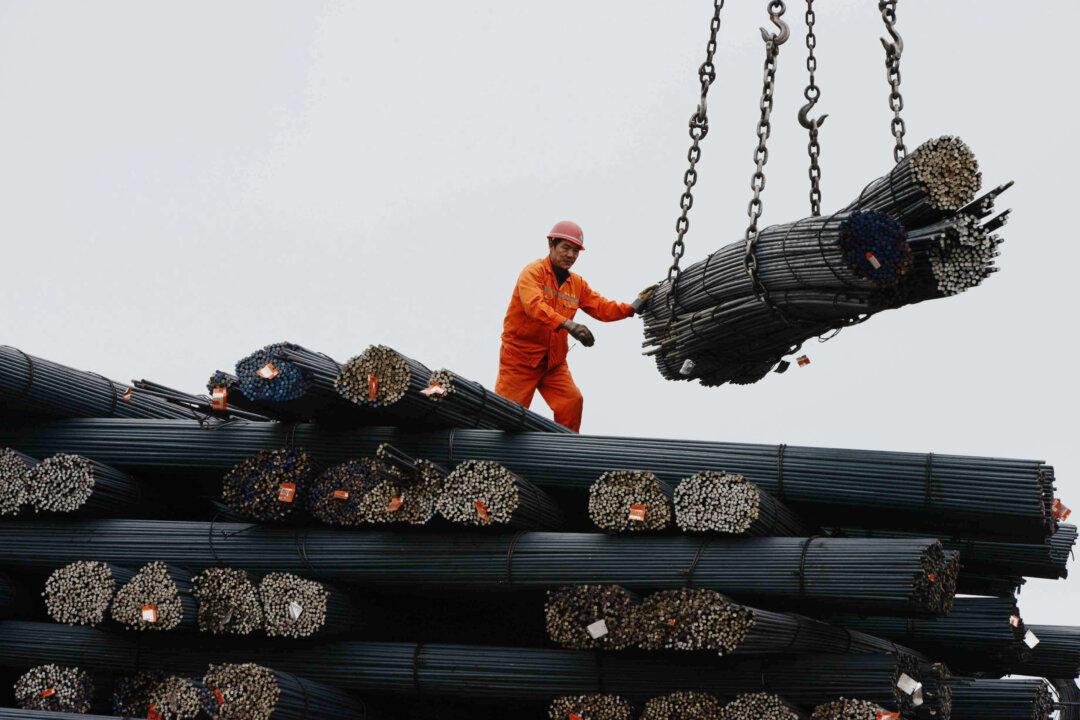China’s economy is in crisis. Since June, investors have been preoccupied with the shortage of money in China’s financial system, but while that shortage reveals much that is wrong in China’s formerly high-flying economy, the systemic problems go far beyond tight money.
The shortage in money occurred because an increase in the demand for capital coincided with a reduction of money flowing into the system and an increase in money flowing out.
In the past few years, China’s banks began offering wealth-management products in a big way. With these financial instruments, the banks offer investors a chance to put their money into highly speculative projects in exchange for a higher rate of return. In June, the banks’ investment in wealth-management products caused the need for liquidity to soar.
Fitch, one of the three major rating agencies, released a report on June 21 suggesting that China’s banks had 1.5 trillion yuan (US$245 billion) in wealth-management products that matured at the end of June, with China’s medium-size banks having put 20 to 30 percent of their deposits in such products.
The latest research data of Puyi Investing Consulting Co. shows that in the last week of June, a total of 1592 wealth-management products offered by banks matured.
The need to pay back 1.5 trillion yuan significantly and suddenly increased the demand for yuan within a short period of time.
Less Coming In
The reduction in recent years in China’s export surplus has indirectly reduced the money supply. With less foreign exchange surplus, the amount of yuan released by the People’s Bank of China for buying U.S. dollars has correspondingly declined.
An attempt to clean up the foreign exchange system by the State Administration of Foreign Exchange has to some degree blocked the passage into China of hot money—money that moves into a market for the sake or short-term gains, further limiting the money supply.
In the past, businesses would file false export reports that would allow them to bring foreign exchange into China. They would then profit off arbitrage—trades that make money off the differences in the exchange rates and interest rates.
A new rule for strengthening the management of foreign exchange inflows has substantially reduced the amount of foreign exchange brought in through the false reporting of exports. As a result, the amount of yuan that the People’s Bank of China is obliged to convert into foreign currency has been reduced.
More Going Out
While less money is flowing into China, more money is flowing out, in part due to corruption.
More than any other single initiative, the administration of new Chinese Communist Party chief Xi Jinping has been marked by his aggressive anti-corruption campaign. Fearing losing what they stole, many senior officials have transferred their money overseas.
The corruption of CCP officials permeates China’s entire economy and complicates managing that economy. There are no statistics on how much black money there is or how much of it has been transferred abroad. Some banks may appear to have a lot of money on their books, but in fact are empty shells.
Foreign direct investment is also bringing less money into China. According to the 2013 A.T. Kearney Foreign Direct Investment Confidence Index released on June 26, the United States is the world’s best place to invest, with China demoted to second place. China’s economic outlook is not optimistic and its expected economic growth rate is only 7 percent, much lower than in the past.
Money that would have headed to China is now going to the United States. Also, some investments that were previously made have been withdrawn.
Overcapacity
With less money flowing into China, a global economic crisis reducing demand worldwide for China’s products, and the end of the high rates of increase previously reached by the Chinese economy, the bubbles in China’s economy are being exposed. In 2011, China used 60 percent of its productive capacity.
Major industries afflicted by overcapacity include chemicals, steel and iron, cement, electrolytic aluminum, flat glass, and photovoltaic cells.
Take as an example the iron and steel industry. This year, the demand for steel and iron is estimated to be about 700 million tons while the production capacity is about 1 billion tons. This May, the raw steel production was 67 million tons in China, which accounted for almost half of the global production.
According to a report by the state-run media outlet Beijing Times, Pingte Iron and Steel Co. Ltd. in Jiangxi Province went bankrupt recently because it could no longer get credit.
In fact, this company had been operating at a loss for a long time. If the company stopped production, its crisis would be immediately exposed. So the company continued production in the hope of convincing banks to believe in its ability to make a profit. However, the banks did not lend it money, and the company went bankrupt.
Many other small steel companies in China, like Pingte, face closure or have already closed. According to mysteel.com, a Chinese Internet portal dedicated to the iron and steel industry, a survey of 163 steel companies on March 8 shows that 66.87 percent of iron and steel companies are operating at a loss.
Factory closure is a result of overcapacity, overstocking, and loss of credit. Overcapacity has not only wasted money, manpower, and national resources, but has also led to massive layoffs of workers, resulting in social instability. Large amounts of credit from banks for these companies have become bad loans and uncollectible.
Markets Shaken
The money shortage has been the highly visible part of the systemic problems plaguing China’s financial system.
The most direct trigger for the crisis in June was the failure by China Everbright Bank to repay a loan to the Industrial Bank. No one knows how many banks and financial institutions face a situation similar to Everbright’s.
After Everbright defaulted, the short-term interest rate, overnight rate, and weekly rate went up sharply, with the overnight rate jumping from 2 to 3 percent to 13.44 percent.
According to Sound of Hope Radio Network, the interest rates for financial products offered by many banks and wealth-management companies in China suddenly soared recently.
For example, the Zhengzhou Branch of Huaxia Bank’s 36-day wealth-management product has an interest rate of 7 percent, while Industrial Bank’s Shenzhen offered a 31-day wealth-management product with an interest rate of 7.5 percent. The market rate before June was normally 3 to 4 percent.
A shortage of money reduces banks’ credit and people’s confidence in the economy. As the banks have recently had problems one after another, the Chinese stock market has gone down again and again.
At one point in June, the stock market had declined by 19 percent. On June 24, the stock market fell 5.3 percent in one day and suffered another drop of 5.8 percent right after the opening on June 25.
After intervention from the People’s Bank of China, the stock market rebounded a little. In fact, such intervention can only temporarily stabilize the market, but cannot fundamentally resolve the long-standing problems in China’s financial industry.
Normally the long-term interest rate moves up when people have a positive economic outlook, and the short-term interest rate goes up when capital demand increases or money supply decreases.
With China’s GDP growth rate this year expected to be only about 7 percent, far below that of previous years, the expected return on investment is naturally lower than before. However, China now has a low long-term interest rate and a short-term interest rate that is much higher than the long-term rate. This structure, called an inverse yield curve, shows that the market is not optimistic about the Chinese economy.
Tianlun Jian, Ph.D., writes regularly on the Chinese economy. He blogs at chineseeconomictrend.blogspot.com.
Read the original Chinese article. http://chineseeconomicanalysis.blogspot.com/




